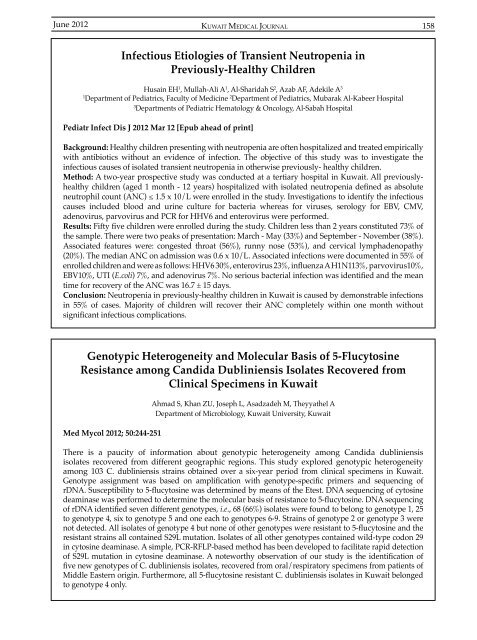Vol 44 # 2 June 2012 - Kma.org.kw
Vol 44 # 2 June 2012 - Kma.org.kw
Vol 44 # 2 June 2012 - Kma.org.kw
Create successful ePaper yourself
Turn your PDF publications into a flip-book with our unique Google optimized e-Paper software.
<strong>June</strong> <strong>2012</strong><br />
KUWAIT MEDICAL JOURNAL 158<br />
Infectious Etiologies of Transient Neutropenia in<br />
Previously-Healthy Children<br />
Husain EH 1 , Mullah-Ali A 1 , Al-Sharidah S 2 , Azab AF, Adekile A 3<br />
1<br />
Department of Pediatrics, Faculty of Medicine 2 Department of Pediatrics, Mubarak Al-Kabeer Hospital<br />
3<br />
Departments of Pediatric Hematology & Oncology, Al-Sabah Hospital<br />
Pediatr Infect Dis J <strong>2012</strong> Mar 12 [Epub ahead of print]<br />
Background: Healthy children presenting with neutropenia are often hospitalized and treated empirically<br />
with antibiotics without an evidence of infection. The objective of this study was to investigate the<br />
infectious causes of isolated transient neutropenia in otherwise previously- healthy children.<br />
Method: A two-year prospective study was conducted at a tertiary hospital in Kuwait. All previouslyhealthy<br />
children (aged 1 month - 12 years) hospitalized with isolated neutropenia defined as absolute<br />
neutrophil count (ANC) ≤ 1.5 x 10/L were enrolled in the study. Investigations to identify the infectious<br />
causes included blood and urine culture for bacteria whereas for viruses, serology for EBV, CMV,<br />
adenovirus, parvovirus and PCR for HHV6 and enterovirus were performed.<br />
Results: Fifty five children were enrolled during the study. Children less than 2 years constituted 73% of<br />
the sample. There were two peaks of presentation: March - May (33%) and September - November (38%).<br />
Associated features were: congested throat (56%), runny nose (53%), and cervical lymphadenopathy<br />
(20%). The median ANC on admission was 0.6 x 10/L. Associated infections were documented in 55% of<br />
enrolled children and were as follows: HHV6 30%, enterovirus 23%, influenzaAH1N113%, parvovirus10%,<br />
EBV10%, UTI (E.coli) 7%, and adenovirus 7%. No serious bacterial infection was identified and the mean<br />
time for recovery of the ANC was 16.7 ± 15 days.<br />
Conclusion: Neutropenia in previously-healthy children in Kuwait is caused by demonstrable infections<br />
in 55% of cases. Majority of children will recover their ANC completely within one month without<br />
significant infectious complications.<br />
Genotypic Heterogeneity and Molecular Basis of 5-Flucytosine<br />
Resistance among Candida Dubliniensis Isolates Recovered from<br />
Clinical Specimens in Kuwait<br />
Med Mycol <strong>2012</strong>; 50:2<strong>44</strong>-251<br />
Ahmad S, Khan ZU, Joseph L, Asadzadeh M, Theyyathel A<br />
Department of Microbiology, Kuwait University, Kuwait<br />
There is a paucity of information about genotypic heterogeneity among Candida dubliniensis<br />
isolates recovered from different geographic regions. This study explored genotypic heterogeneity<br />
among 103 C. dubliniensis strains obtained over a six-year period from clinical specimens in Kuwait.<br />
Genotype assignment was based on amplification with genotype-specific primers and sequencing of<br />
rDNA. Susceptibility to 5-flucytosine was determined by means of the Etest. DNA sequencing of cytosine<br />
deaminase was performed to determine the molecular basis of resistance to 5-flucytosine. DNA sequencing<br />
of rDNA identified seven different genotypes, i.e., 68 (66%) isolates were found to belong to genotype 1, 25<br />
to genotype 4, six to genotype 5 and one each to genotypes 6-9. Strains of genotype 2 or genotype 3 were<br />
not detected. All isolates of genotype 4 but none of other genotypes were resistant to 5-flucytosine and the<br />
resistant strains all contained S29L mutation. Isolates of all other genotypes contained wild-type codon 29<br />
in cytosine deaminase. A simple, PCR-RFLP-based method has been developed to facilitate rapid detection<br />
of S29L mutation in cytosine deaminase. A noteworthy observation of our study is the identification of<br />
five new genotypes of C. dubliniensis isolates, recovered from oral/respiratory specimens from patients of<br />
Middle Eastern origin. Furthermore, all 5-flucytosine resistant C. dubliniensis isolates in Kuwait belonged<br />
to genotype 4 only.
















